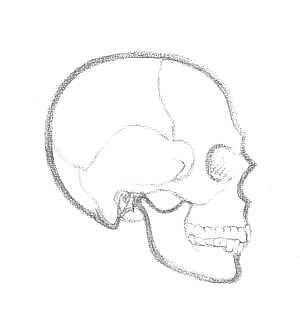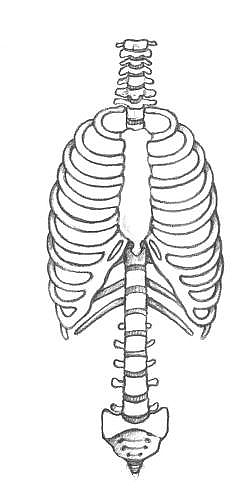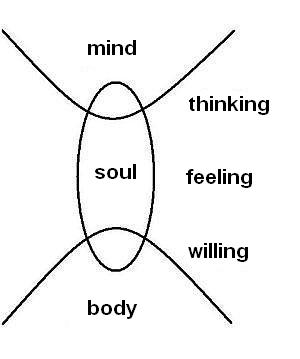
In the Heart - the loom of Feeling,
In the Head - the light of Thinking,
In the Limbs - the strength of Will.
Rudolf Steiner
The threefold human being

Looking at the human skeleton a polarity can be distinguished with a centre. This observation induces us to have a look at the threefoldness of man, where we can see three functional organsystems. It is also an introduction to the threefoldness of mammals.
The skeleton
The polarity of skull and limbs
The human skeleton consists of a large number of differently shaped bones. At first sight, the round head and the long limbs with the chest and spine inbetween strike us as three diferent parts of the skeleton.
- The skull has a predominantly round shape and the bones are curved plates that have grown together.
- The limbs consist of independent elongated tubular bones. They radiate: from top to bottom there are one humerus, two forearm bones, 3 to 4 bones in the hand and 5 fingers.
In the skull are the brains and the senses, they are protected by the bones. Whereas the muscles of the limbs are on the outside; the bones do not protect the muscles. Another difference is that the limbs are in motion, in the skull rest prevails.
The processes within the skull are sense and nerve processes, where awareness is needed. The temperature must remain constant and the blood supply to the brains must be steady. In the limbs we do not need awareness, they can function without it. The temperature may change and the blood supply may be interrupted for a while without irreparable damage. Damage to the limbs is reversible, whereas damage tot the brains is in most cases irreversible.
The middle: the chest and spine
Between the skull and limbs are the ribs of the chest and the spine. Like the bones in the limbs ribs are elongated tubes; like those in the skull, they are bent. With their oval shape they take an intermediate position between the rounded head and the straight limbs. The chest as a whole is oval in shape, too.
The thorax is not completely closed, but half-open. It gives some protection to the heart and the lungs. The ribs move while breathing. We can influence the strength of our breathing by moving our ribs and the muscles of our abdomen.The upper ribs are firmly attached to the breastbone. Lower down the connection is less firm as these ribs are connected to the cartilage of the lower part of the breastbone. The two lower ribs are loose - the so-called floating ribs. Ribs and chest take a middle position between the skull and the limbs. They lie around the heart and the lungs, but do not fully protect.
The heart takes care of the blood circulation and beats about 72 times per minute. The lungs provide the body with new air and we breathe about 12 times a minute. Both are rhythmically moving organs.
The spine is in this area, too. The s-shaped spine consists of more than 30 vertebrae that are all a little bit different. The discs have a circular shape with protrusions, a combination of the rounded form and the straight form. The vertebrae are loosely joined together and the spine is flexible. We may call this: rhythm in form.
In the chest area, we see characteristics of both polarities and a characteristic of its own, namely rhythm.
| skull | thorax | limbs | |
| overall shape | spherical | oval | radiant |
| shape of the bones | flat plates | oval (ribs), round and straight (vertebrae) | tubular, long |
| connection | firmly connected | semi-loose | loose |
| function of the skeleton | protects the brains | half open, protects heart and lungs | attaches the muscles |
| temperature | constant | variable | |
| recoverability organ tissue | no | in between | yes |
| characteristic | round | rhythm | straight |
| movement | not | automatic | conscious |
Table 1. Features of skull, thorax and limbs
Threefoldness of the functional organsystems
Based on the three parts of the skeleton, three functional organsystems can be distinguised, that are associated with the skeleton. We will see that each has its own characteristics.
The nerve-sense system
In the head are the brains and the most important senses (eye, ear, balance, smell, taste). The nervous-system with the senses has its centre in the skull and radiates to all parts of the body. We feel with our little toe, too. The senses and the brains are focused on observing and thinking. There is no outward movement, but an inner, because the observations come to consciousness and processes of thinking and imagination take place.
Movement of the brains is dangerous. A concussion heals with rest. When we think, we should keep our head cool. Activity of the brain and the sense organs produces little heat. It also costs little energy. Much thinking even makes cold. Thinking and perception are conscious processes, which have no effect on the environment. With thoughts alone, nothing happens in the world.
The senses observe the surroundings and ourselves. By processing the observations in our mind we come to consciousness of the environment and ourselves. The senses are focused on the outer world, the brains on the inner world where thinking takes place. Observing makes us define ourselves as different from the environment, demarcation arises.
Although we observe in the present, what we observe already exists. Because we can only observe what is there, the senses are focused on the past. When we think, we think about existing things. When we go somewhere new, we make an image using existing observations. If something new is invented or thought, it has to be made first to find out whether the idea is real or a phantasy.
The rhythmic or heart-lung system
In the chest are the heart and the lungs. The heart keeps the blood in motion. The lungs take in air and ensure the supply of oxygen. The centre of the respiratory and circulatory system is in the chest. Bloodvessels are found throughout the body, they transport oxygen. These are the organs which are in automatic regular rhythmic motion. The chest protects the lungs and heart, but does not cover them completely.
In the heart-lung system a shifted symmetry can be observed. The heart is not completely symmetrical and is off centre in the chest, in the lungs there are two lobes on the left and three on the right, nor are they symmetrical. These organs respond to what we experience. Of our heart and lungs we are semiconscious. We can feel them when we focus on them. The muscles in our abdomen and the ribs can be moved consciously to intensify our breathing.
With the heart and lungs we connect ourselves rhythmically with the present. Heart and lungs show our inner state in the present and our response to the environment. The lungs react to the outsite world, the heart responds to the inner self. They show and express how we feel. When we are startled, our breathing falters. When we are afraid, the heart beats faster and when we are relaxed, it beats slower.
Metabolic-limb system
The muscles that are connected to the limbs are the biggest we have. They are the centre of movement. On the head, of course, there are also muscles. The movement in the head area is, apart from the jaw, small. This applies to the breast area in a lesser degree. When muscles are working, they get warm. If they are cold, it is wise not set them to deliver a great performance, because of a high probability of damage. We can count ourselves lucky that damaged muscles heal!
Movement of the muscles is an unconscious activity that requires energy. If you know what you want to do, the muscles do it for you. If you want to take a glass of water, your muscles do it, you do not have to direct or control them. If you want to write, you only have to think about the words and your hand and fingers do it for you.
Then there are the stomach and digestive organs. Do they belong to the chest or to the limbs? The digestive system is in movement, but not rhythmic like breathing and the heartbeat.
It only becomes active after eating and it works without us noticing it; digesting food in an unconscious process.
The stomach and the intestines in the abdomen are much more open than the heart and lungs are in the chest. Much like the muscles on the limbs, so are the organs in the abdominal cavity open and exposed. The digestive system digests food so that we can absorb the nutrients and maintain our body. This is similar to what the limbs do. They make new items with existing substances and materials. What the limbs do outsite the body, digestion does inside the body, viz.: converting substance and transform it to our needs. Both intervene in- and change the world, both are unconscious processes. Digestive organs and limbs belong together. Through the metabolic-limb system there is an intense connection to the material world. Matter is transformed and converted to our wishes and needs.
The limbs are active in the environment, the digestive system in our body. Because everything that is made is new (it was not there), this functional system is focused on the future. Something only happens when we become active, when we do it. We don't do things unless we want to do them. Doing or willing is the activity that goes with this system.
This functional system also includes the reproductive organs.
| nerve-sense system | heart-lung system | metabolic-limb system | |
| bones | outside | half-open | inside |
| outer movement | non, rest | automatic, rhythmic, can be enhanced | much |
| temperature | cold, stable | warm, changing | |
| consciousness | conscious | semi-conscious | not conscious |
| inner process | thinking | blood circulation | digestion |
| outer process | observing | breathing | doing / willing |
| characteristic | demarcation | rhythm | connection |
| time | past | present | future |
Table 2. Features of the three functional organ systems
Threefoldness and the soul
Thinking, feeling and doing or willing form the three faculties of the soul and their physical basis is in the three functional organ systems. The soul can be seen as the link between body and mind. Man is seen as an eternal spirit or individuality that has a body. To use the body the soul is the mediator for the mind. Of the three faculties, thinking is closest to the mind and doing is closest to the body.
Thinking
Thinking and observing are processes that require consciousness and vigilance. If one is without attention, tired, ill or sleepy it will be more difficult to think or observe well. It is possible to follow ones thoughts all the way. By thinking we can understand other people, organisms, thoughts or things. Through observing we demarcate ourselves from the world outside. Thought is the basis for self-awareness. It has already been mentioned that one can only think about existing things. Awareness, wakefulness and demarcation are concepts that belong to thinking.
Feeling
One can never feel as clear as one can think. Our feelings are more diffuse, they are semi-conscious and remain in a dreamworld. We can influence our feelings by thinking. Feelings arise immediately, we can't do much about them. They are just there and they are a reaction to what one experiences. By feeling compassion, one is able to connect with another person. With our feeling we are able to connect and let loose in a rhythmic manner, one can also say: in a breathing manner. Semi-consciousness, dreamlike and a rhythmic or breathing connection are concepts that go with feeling.
Doing or willing
Limbs are made for creative processes. The limbs and the digestive organs do their work without evidence of awareness. A sentence is thought and the hands type the words automatically, without having to think about what they must do. It is even the other way around: if you were to instruct your fingers consciously, typing would cost much effort and time. We are sleepy in our limbs when we accomplice an action. It happens without active involvement. We constantly make new things and are creative. Through the will we interfere in the world. Unconsciousness, sleepiness and creation are concepts connected to doing or willing.
Threefoldness of the head
We can also examine whether threefoldness can be found in the skeleton at another level, e.g. in the head.
The skull has an overall round shape. In the facial skull, we do not see that. The lower jaw is dominated by elongated shapes. The lower jaw is the mobile part of the skull and the bones are not round as in the limbs, but flat. The mouth is the beginning of the digestive tract. Between brain skull and lower jaw is the area of the nose and the inner cavities (dental cavities, nasal passages, sinuses) involved in breathing. With every breath fresh air is inhaled. There is pain when a cavity is obstructed (sinusitis), because in that case there is no free flowing air. We can define blushing as an expression of feeling, also visible in the middle of the face.
Within the nerve-sense area, which is mainly the skull, this distribution is shown:
- the brain skull is round and contains the brains and some senses, it is the nerve-sense area,
- the cavities and the nose form the heart-lung area,
- the mouth and the lower jaw form the elongated and mobile metabolic-limb area.
The mouth
We can even go further and take a look at the mouth. The lips, the tip of the tongue and the teeth are very sensitive. We take food carefully into our mouth. We wonder how it will taste and whether it is hard or soft, warm or cold. In the central part of the mouth these tastes are determined. Whether we think it is delicious and/or healthy or not is defined here. Finally, the food reaches the throat area, which is the unconscious area of metabolism. We do not taste much anymore, only notice it when something is too big or too hot, because then the throat hurts. Swallowing something like a big pill consciously is more difficult than unconsciously. Here we see the three areas again. In the front: observe (consciously), halfway: judge (half-consciously) and in the throat: metabolism (unconsciously).
The teeth
In the teeth we see threefoldness, too. The teeth are the most sensitive, they feel the food, the canines are there for grip and the molars to grind food. The teeth are curved in a row and the molars form a straight line.
From these examples can be seen that within the nerve-sense system of the skull the same principles of the three organ systems are found on another level, and that even inside the mouth and teeth the three systems can be distinguished.
(Drawings from Rohen (Morphologie des menschlichen Organismus) and the internet)

The skeleton of man

The round skull with the straight lower jaw

The radiant arm

The many elements of the chest and the spine

The oval shape of the ribs

The coherence of body, soul and mind
